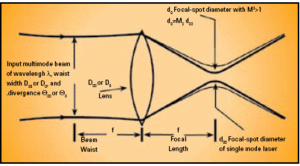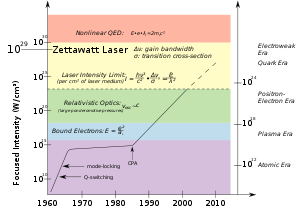For non-specific tissue heating as in skin rejuvenation systems do not have a specific chromophore! But till recently we have been on the lookout for the ‘ideal’ wavelength. Er-YAG, Er-Glass, CO2 all have been tried with limited success though the fractional technology has improved the safety profile considerably.
| Laser beam quality – M2 definition (Photo credit: Wikipedia) |
Innovations happen when dogmas are challenged!
Scientists from Philips Research in Eindhoven have prototyped a system that do not depend on selective photothermolysis and hence not on any specific chromphore/wave length. The new system uses advanced optics to focus a laser beam below the epidermis. High laser intensity at the focal point induces a little known (to me) phenomenon called ‘Light Induced Optical Breakdown’ (LIOB) creating a mini ‘explosion’ along a short distance!
| Graph showing the history of maximum laser pulse intensity throughout the past 40 years. (Photo credit: Wikipedia) |
This conceptually different system has many advantages. Since it uses a converging beam, the laser intensity on the surface is very less and hence the surface changes and pain are virtually nil. However the sub-epidermal effect is similar to or probably more than ablative systems. So you end up giving ablative results at no pain and no downtime.
This should bring a paradigm shift in the present selective photothermolytic systems.
I give full five peels for this technology.

What is peel score?
Reviewed by Bell Eapen on .
Scientists from Philips Research in Eindhoven have prototyped a new system that does not depend on selective photothermolysis.
Scientists from Philips Research in Eindhoven have prototyped a skin rejuvenation technology that does not depend on selective photothermolysis and hence not on any specific chromphore/wave length. This should bring a paradigm shift in the present selective photothermolytic systems.
PeelScore rating: 5

- Machine learning-based BOTOX API - April 11, 2023
- Skinmesh: Machine learning for facial analysis - November 10, 2020
- Free Dermatology EMR for Machine Learning and Artificial Intelligence - January 2, 2020






Leave a Reply